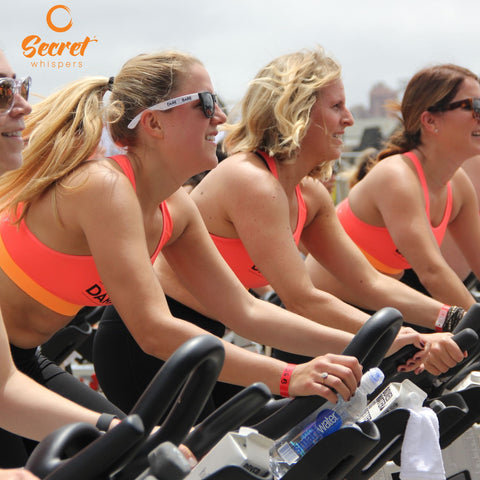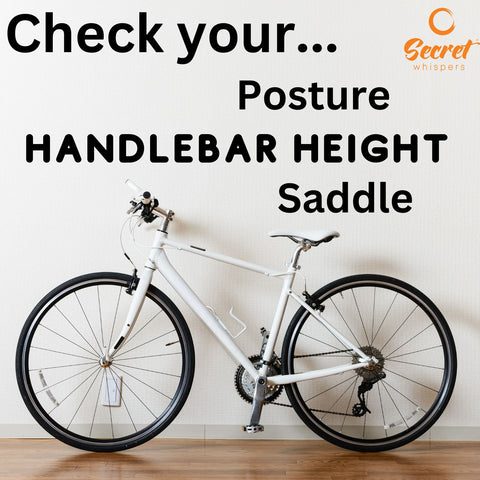Cycling And The Pelvic Floor
When we are faced with the problems surrounding a weak pelvic floor, it is common to avoid doing exercise because we are worried we may leak and this can obviously be embarrassing.
However keeping fit and keeping our weight down can help reduce the strain on our pelvic floor muscles. Regular exercise helps your body stay strong and healthy.
You will have heard of Kegel exercises (pelvic floor exercises), and how they are vital to keep your pelvic floor in tip top condition, and you might have even tried our 30 Day Pelvic Floor Challenge to help you achieve peak pelvic floor fitness.
If you are a newbie to Kegels, check out our Step By Step Guide To Do Kegel Exercises
Using a set of our Kegel Weights can also be invaluable in training your pelvic floor muscles, so you can exercise, dance, cough or sneeze without worry.
Cycling has become an increasingly popular mode of exercise and transport, both from a fitness point of view and also in a bid to try to reduce our carbon footprint. However, it is important that we know about the stress that it can put on your pelvic area and to understand how to minimise the stress on your pelvic floor muscles.
There are many health benefits to cycling, including improved cardio-vascular health, better weight control and decreased risk of breast cancer in women (1).
But is riding your bike giving you pelvic floor issues?
Can Cycling Damage Your Pelvic Floor?

Well, the answer to that is both yes, and no.
In spite of all the amazing health benefits we can get from getting out on two wheels, ask anyone who has ever ridden a bike whether the seat is somewhat uncomfortable and you will get an almost unanimous show of hands!
On the occasions that I do a bike rides with my children, a numb bum is pretty much inevitable. For some, though, issues worse than numb nether regions can develop, such as genital numbness and pain, urinary incontinence and sexual dysfunction (2).
Cycling and spinning are great ways to support your pelvic floor and improve symptoms of a pelvic prolapse.
This can, however lead to a prolapse when done too often and over long periods of time, because of the continuous weight and pressure on the pelvic floor.
This in turn can affect circulation in that area and irritate and compress the nerves in the pelvic floor. For more on this, see our blog Spinning and Incontinence
Can Cycling Cause Incontinence?
According to Aeroflow Urology (3) urinary incontinence can result from cycling too often and for too long. Done in moderation, cycling and spinning is usually a comfortable sport for women, but, as Aeroflow Urology agree, if done too extensively, can lead to different types of incontinence:
- Stress incontinence- the consistent pressure on your bladder exceeds the force of the muscles holding the bladder shut.
- Urge incontinence- when the urge to urinate arrives with little or no time before the urine is released. The muscle that covers your bladder is under voluntary and involuntary nervous control. This is what tells your brain “I need to pee!” to save your bladder from exploding. Damage to this nerve can irritate it, releasing the urge to urinate.
Functional incontinence- this is almost exclusive to cyclists as they squeeze themselves into spandex and lycra bibs. Functional incontinence happens when you have an accident because you're unable to remove clothing fast enough or make it to the bathroom fast enough due to some physical or mental barrier.
How To Protect the Pelvic Floor When Cycling

If cycling or spinning is your thing, there are some things you can use to protect your pelvic floor from further damage, or to nip it in the bud before it causes an issue. Knowledge is power after all!.
You may want to consider the following:
- Your Bicycle Seat
- Handlebar Height
- Regular Breaks
- Watch Your Posture
- Breathing
Your Bicycle Seat
There are many different saddles available to help protect your pelvic floor when cycling. I have a lovely ladies padded saddle that I bought for my new bike.
Finding the right saddle for you is a process. Talk to your local bike shop and ask lots of questions. They will have heard the issues women have in choosing the correct saddle for their pelvic floor. Don't forget to get some padded cycling shorts or bottoms as well. They are fantastic!
Handlebar Height
Do you have your handlebars low? Sorry to have to tell you this – but, a lower handlebar can have a negative on your pelvic floor.
A study showed that:
The pressure values for females were significantly greater when the riders’ hands were placed in the drops of the handlebars compared to those whose were positioned on the tops of the handlebars [14].
Regular Breaks
There is never anything to be gained from over-exercising.
Before you even consider the impact upon your pelvic floor, over-exercising can lead to exhaustion, muscle strain, stress fractures and just inefficient workouts.
So, it’s always advised to take two days rest a week, and also little breaks within your cycling sessions. Just as you can strain and stress the rest of your body, the same applies to your pelvic floor.
Cycle mindfully, paying attention to your body, and the signals your pelvic floor is giving you. If you notice and pain, tingling, urge incontinence or numbness, stop and rest, and wait at least 48 hours between rides.
Watch Your Posture
The most popular position for cyclists to assume while riding is to lean forward, close to the bike and tense. But, it seems that this is the worst position for your pelvic floor as it puts downward pressure on the area.
So, if you want to cycle, pay particular attention to your posture.
Try sitting up straight, and relax. Keeping your neck straight and looking forward will move the pressure to the lovely cushioned area on your bottom instead! We were given a soft bit, may as well use it!
Breathing
Holding your breathe puts additional strain on your abdomen and pelvic floor… breathe deeply while cycling and don’t forget to relax your tummy muscles.
In Conclusion
If you want to use your bike or take a spin session or two to get in shape and stay fit, just be aware of your pelvic floor and all the tips above to ensure you minimise the stress on your pelvic floor!
Bear in mind the helpful information included here, and listen to your body at all times. Regular rests, and stop if you feel any discomfort. As long as you follow the guidelines, get on that bike and ride!
AND - Do your Kegels twice a day!:-)
➡️ To learn more how our Pelvic Floor Exercise Weights work, head over here. Secret Whispers Pelvic Floor Training Weights
➡️ You can also join our fabulous womens only private Facebook Group
➡️ Fancy a FREEBIE? Download our FREE guide The easy way to get a stronger pelvic floor
➡️ The 30 Day Pelvic Floor Challenge - Join the waiting list
Any questions? Just email us at support@secretwhispers.co.uk and we will get straight back to you.
Never miss another blog again and sign up here. You will get a 10% discount code to use too.
Other 'Dribbles' you may wish to read:
Have I got a prolapse? Signs and symptoms explained.
The 4 Main Types of Pelvic Floor Prolapse with Reference Diagrams
External Sources:












